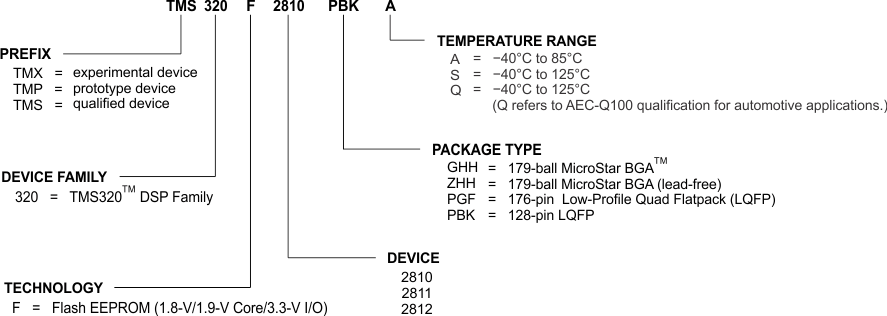JAJSHM4U April 2001 – July 2019 TMS320F2810 , TMS320F2811 , TMS320F2812
PRODUCTION DATA.
- 1デバイスの概要
- 2改訂履歴
- 3Device Comparison
- 4Terminal Configuration and Functions
-
5Specifications
- 5.1 Absolute Maximum Ratings
- 5.2 ESD Ratings – Commercial
- 5.3 ESD Ratings – Automotive
- 5.4 Recommended Operating Conditions
- 5.5 Power Consumption Summary
- 5.6 Electrical Characteristics
- 5.7 Thermal Resistance Characteristics for 179-Ball ZHH Package
- 5.8 Thermal Resistance Characteristics for 179-Ball GHH Package
- 5.9 Thermal Resistance Characteristics for 176-Pin PGF Package
- 5.10 Thermal Resistance Characteristics for 128-Pin PBK Package
- 5.11 Thermal Design Considerations
- 5.12
Timing and Switching Characteristics
- 5.12.1 Timing Parameter Symbology
- 5.12.2 Power Supply Sequencing
- 5.12.3 Reset Timing
- 5.12.4 Clock Specifications
- 5.12.5
Peripherals
- 5.12.5.1 General-Purpose Input/Output (GPIO) – Output Timing
- 5.12.5.2 General-Purpose Input/Output (GPIO) – Input Timing
- 5.12.5.3 Event Manager Interface
- 5.12.5.4 Low-Power Mode Wakeup Timing
- 5.12.5.5 Serial Peripheral Interface (SPI) Master Mode Timing
- 5.12.5.6 Serial Peripheral Interface (SPI) Slave Mode Timing
- 5.12.5.7 External Interface (XINTF) Timing
- 5.12.5.8 XINTF Signal Alignment to XCLKOUT
- 5.12.5.9 External Interface Read Timing
- 5.12.5.10 External Interface Write Timing
- 5.12.5.11
External Interface Ready-on-Read Timing With One External Wait State
- Table 5-31 External Memory Interface Read Switching Characteristics (Ready-on-Read, 1 Wait State)
- Table 5-32 External Memory Interface Read Timing Requirements (Ready-on-Read, 1 Wait State)
- Table 5-33 Synchronous XREADY Timing Requirements (Ready-on-Read, 1 Wait State)
- Table 5-34 Asynchronous XREADY Timing Requirements (Ready-on-Read, 1 Wait State)
- 5.12.5.12 External Interface Ready-on-Write Timing With One External Wait State
- 5.12.5.13 XHOLD and XHOLDA
- 5.12.5.14 XHOLD/XHOLDA Timing
- 5.12.5.15
On-Chip Analog-to-Digital Converter
- Table 5-40 ADC Absolute Maximum Ratings Over Recommended Operating Conditions (Unless Otherwise Noted)
- Table 5-41 ADC Electrical Characteristics Over Recommended Operating Conditions (Unless Otherwise Noted)—AC Specifications
- Table 5-42 ADC Electrical Characteristics Over Recommended Operating Conditions (Unless Otherwise Noted)—DC Specifications
- 5.12.5.15.1 Current Consumption for Different ADC Configurations
- 5.12.5.15.2 ADC Power-Up Control Bit Timing
- 5.12.5.15.3 Detailed Description
- 5.12.5.15.4 Sequential Sampling Mode (Single-Channel) (SMODE = 0)
- 5.12.5.15.5 Simultaneous Sampling Mode (Dual-Channel) (SMODE = 1)
- 5.12.5.15.6 Definitions of Specifications and Terminology
- 5.12.5.16
Multichannel Buffered Serial Port (McBSP) Timing
- 5.12.5.16.1 McBSP Transmit and Receive Timing
- 5.12.5.16.2
McBSP as SPI Master or Slave Timing
- Table 5-49 McBSP as SPI Master or Slave Timing Requirements (CLKSTP = 10b, CLKXP = 0)
- Table 5-50 McBSP as SPI Master or Slave Switching Characteristics (CLKSTP = 10b, CLKXP = 0)
- Table 5-51 McBSP as SPI Master or Slave Timing Requirements (CLKSTP = 11b, CLKXP = 0)
- Table 5-52 McBSP as SPI Master or Slave Switching Characteristics (CLKSTP = 11b, CLKXP = 0)
- Table 5-53 McBSP as SPI Master or Slave Timing Requirements (CLKSTP = 10b, CLKXP = 1)
- Table 5-54 McBSP as SPI Master or Slave Switching Characteristics (CLKSTP = 10b, CLKXP = 1)
- Table 5-55 McBSP as SPI Master or Slave Timing Requirements (CLKSTP = 11b, CLKXP = 1)
- Table 5-56 McBSP as SPI Master or Slave Switching Characteristics (CLKSTP = 11b, CLKXP = 1)
- 5.12.6 Emulator Connection Without Signal Buffering for the DSP
- 5.12.7 Interrupt Timing
- 5.12.8 Flash Timing
-
6Detailed Description
- 6.1
Brief Descriptions
- 6.1.1 C28x CPU
- 6.1.2 Memory Bus (Harvard Bus Architecture)
- 6.1.3 Peripheral Bus
- 6.1.4 Real-Time JTAG and Analysis
- 6.1.5 External Interface (XINTF) (F2812 Only)
- 6.1.6 Flash
- 6.1.7 M0, M1 SARAMs
- 6.1.8 L0, L1, H0 SARAMs
- 6.1.9 Boot ROM
- 6.1.10 Security
- 6.1.11 Peripheral Interrupt Expansion (PIE) Block
- 6.1.12 External Interrupts (XINT1, XINT2, XINT13, XNMI)
- 6.1.13 Oscillator and PLL
- 6.1.14 Watchdog
- 6.1.15 Peripheral Clocking
- 6.1.16 Low-Power Modes
- 6.1.17 Peripheral Frames 0, 1, 2 (PFn)
- 6.1.18 General-Purpose Input/Output (GPIO) Multiplexer
- 6.1.19 32-Bit CPU-Timers (0, 1, 2)
- 6.1.20 Control Peripherals
- 6.1.21 Serial Port Peripherals
- 6.2
Peripherals
- 6.2.1 32-Bit CPU-Timers 0/1/2
- 6.2.2
Event Manager Modules (EVA, EVB)
- 6.2.2.1 General-Purpose (GP) Timers
- 6.2.2.2 Full-Compare Units
- 6.2.2.3 Programmable Deadband Generator
- 6.2.2.4 PWM Waveform Generation
- 6.2.2.5 Double Update PWM Mode
- 6.2.2.6 PWM Characteristics
- 6.2.2.7 Capture Unit
- 6.2.2.8 Quadrature-Encoder Pulse (QEP) Circuit
- 6.2.2.9 External ADC Start-of-Conversion
- 6.2.3 Enhanced Analog-to-Digital Converter (ADC) Module
- 6.2.4 Enhanced Controller Area Network (eCAN) Module
- 6.2.5 Multichannel Buffered Serial Port (McBSP) Module
- 6.2.6 Serial Communications Interface (SCI) Module
- 6.2.7 Serial Peripheral Interface (SPI) Module
- 6.2.8 GPIO MUX
- 6.3 Memory Maps
- 6.4 Register Map
- 6.5 Device Emulation Registers
- 6.6 External Interface, XINTF (F2812 Only)
- 6.7 Interrupts
- 6.8 System Control
- 6.9 OSC and PLL Block
- 6.10 PLL-Based Clock Module
- 6.11 External Reference Oscillator Clock Option
- 6.12 Watchdog Block
- 6.13 Low-Power Modes Block
- 6.1
Brief Descriptions
- 7Applications, Implementation, and Layout
- 8デバイスおよびドキュメントのサポート
- 9メカニカル、パッケージ、および注文情報
パッケージ・オプション
デバイスごとのパッケージ図は、PDF版データシートをご参照ください。
メカニカル・データ(パッケージ|ピン)
- PBK|128
サーマルパッド・メカニカル・データ
- PBK|128
発注情報
8.2 デバイスおよび開発ツールの項目表記
製品開発サイクルの段階を示すために、TIでは TMS320™ DSP デバイスおよびサポート・ツールの型番に接頭辞を使用しています。TMS320 DSP の民生用ファミリの各製品には、TMX、TMP、TMS のいずれかの接頭辞を付けています (たとえば、TMS320F2810)。テキサス・インスツルメンツでは、サポート・ツールに使用可能な 3 つの接頭辞のうち、TMDX および TMDS の 2 つを推奨しています。これらの接頭辞は、製品開発の進展段階を表します。段階には、エンジニアリング・プロトタイプ (TMX/TMDX) から、完全認定済みの量産デバイス/ツール (TMS/TMDS) まであります。
| TMX | 実験的デバイスであり、最終デバイスの電気的特性を必ずしも表しません。 |
| TMP | デバイスの電気的仕様に適合する最終的なシリコン・ダイですが、品質および信頼性検証は完了していません。 |
| TMS | 完全に認定済みの量産版デバイスです。 |
サポート・ツール開発の段階は次のとおりです。
| TMDX | 開発サポート製品で、テキサス・インスツルメンツの社内認定試験はまだ完了していません。 |
| TMDS | 完全に認定済みの開発サポート製品です。 |
TMXおよびTMPデバイスとTMDX開発サポート・ツールは、以下の免責事項の下で出荷されます。
「開発的製品は、社内評価を目的としています。」
TMSデバイスとTMDS開発サポート・ツールの特性は完全に明確化されており、デバイスの品質と信頼性が十分に示されてきました。TI の標準的な保証が適用されます。
プロトタイプ・デバイス(TMXまたはTMP)の方が標準的な製品版デバイスに比べて故障率が大きいと予測されます。これらのデバイスは予測される最終使用時の故障率が未定義であるため、テキサス・インスツルメンツではそれらのデバイスを量産システムで使用しないよう推奨しています。認定された量産デバイスのみを使用する必要があります。
TIデバイスの項目表記には、デバイス・ファミリ名の接尾辞も含まれます。この接尾辞は、パッケージの種類 (例:PBK) と温度範囲 (例:A) を示しています。TMS320F281x ファミリの製品の完全なデバイス名の読み方を示す凡例を、Figure 8-1 に示します。
デバイスの型番、および注文情報の詳細については、このデータシートにあるパッケージ・オプションについての付録や、TI Webサイト(www.ti.com)を参照するか、またはお近くのTI販売代理店にお問い合わせください。
ダイのデバイス項目表記マーキングの詳細説明については、『TMS320F281x DSPs Silicon Errata』 (英語) を参照してください。
